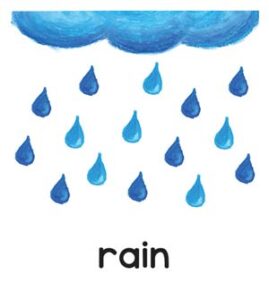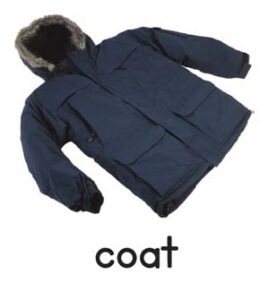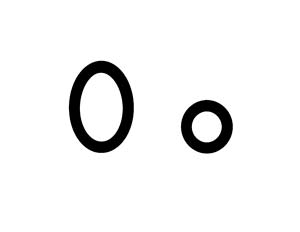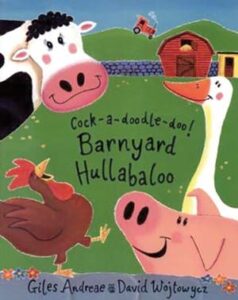Phonological awareness, Letter knowledge
Children will deepen their understanding of a compound word. Children also will identify and name the letter O.


Review:
Be Prepared: Organize three component cards for each child plus yourself. Two of the three cards should form a compound word. Mix up the three component cards in each set. Put in a separate collection the compound word cards that correspond to the “matching” component cards given to children. Keep the collection of compound word cards near you during the activity. Select compound words that readily help children understand that the meaning of a compound word is different than the meanings of its component words. Suggestions include the following: raincoat, basketball, watermelon, pancake, cupcake, fingernail, bookshelf, hotdog, sandbox. The activity plan uses “raincoat” for your demonstration of the activity.
Today each of us is going to make a compound word. Remember, we can make a compound word by putting two words together.
[Give each child three component word cards as described in Be Prepared. Keep one set of three cards for your demonstration of the activity.]
Each of you has three word cards. We will each make one compound word with two of our word cards. I will tell you the compound word you can make with two of your cards. Let me show you.
[Place your three component word cards in front of you. Point to and say the name of each card.]
I have the cards “rain,” “butter,” and “coat.” I want to make the word “raincoat” with two of my cards. I know that the word “raincoat” is made up of two different words. “Raincoat” is a compound word. I am going to listen carefully to the sounds of the word “raincoat.”



The two words we hear in the word “raincoat” are “rain” and “coat.” Now I need to find a card that says “rain” and another card that says “coat.”
[Display each of your three component cards to children, one at a time, and ask for their help in identifying the cards that represent “rain” and “coat.” Invite children to describe each card, including the “butter” card. Explain why this card does not help make the word “raincoat” by emphasizing the sounds of the words. Example: “Does the word ‘butter’ sound like ‘rain’ or ‘coat’?”
Put the “rain” and “coat” cards next to each other, with pictures facing in a direction that children can see. Point to each component card as you describe how you formed the compound word.]
I can make the word “raincoat” with two of my cards. I have put the two cards together. I do not need the other card. I am going to put the other card in a separate place.
[Put the non-matching component card to the side so it does not distract attention away from the “rain” and “coat” cards. Display the “raincoat” compound word card.]



Here is the card that shows the word “raincoat.” Let’s look at each of the cards in front of me. The card with the word “raincoat” shows a picture of a raincoat. A raincoat is something we wear when it is raining outside. A raincoat helps us to keep dry.
Now it’s your turn to try. I will tell each of you the compound word you can make with two of your three cards. Put in front of you the two word cards that make your compound word. After you make your compound word, I will give you the card that says the name of the compound word. Then we will talk about each of our compound words.
[Give children several minutes to make one compound word from their three component word cards. Observe and help if necessary. When a child has formed the designated compound word, give the child the appropriate compound word card.]
Now we are going to take turns talking about our compound word. When we talk about our compound word, we will each have a chance to lead the group in clapping for each part of our compound word. Let me show you.
I have the compound word “raincoat.”
[Point to or hold up the “raincoat” compound word card.]
Let’s clap once for each part of the word “raincoat.”
[Lead children in clapping two times as you say the word “raincoat.”]
We will go in a circle so everyone has a turn to talk about their compound word and lead us in clapping. Let’s begin with _____.
[Use the following questions or prompts for discussion of each child’s compound word.]
Today we are going to learn a different letter of the alphabet.
[Display letter O card.]
Does anyone know the name of this letter?
 This is the letter O. We can write the letter O in two ways. We can write the letter O like this.
This is the letter O. We can write the letter O in two ways. We can write the letter O like this.
[Demonstrate writing an uppercase O at the top of a chart paper.]
This is an uppercase O.
We can also write the letter O like this.
[Demonstrate writing a lowercase o at the top of a chart paper.]
This is a lowercase o.
We are learning what it means to observe something. We know that when we observe something we look carefully at it. Observe is a word that starts with the letter o. I will write this word on our chart. I am going to write the word “observe” with a lowercase (small letter) o.
[Say each letter as you write the word. Emphasize o.]
Let’s all say the word “observe.”
[Invite a volunteer child to point to the letter o in the word “observe.”]
Let’s look at the very first letter of our name. Pop up if you have the letter O at the beginning of your name. Remember, names begin with an uppercase (big) letter.
[Encourage children to look at their name cards. Say the first names of children who have an O at the beginning of their name. If there are children whose name begins with the letter O but do not stand, point to the letter O on their name card. Compare the letter O in their name as you hold the letter O card next to their name card.
If no one in the group has a first name beginning with the letter O, say “No one popped up because no one has a name that starts with the letter O.” Encourage children to look at the list of children’s first names. Point to some first letters of names. Explain that no one’s name begins with the letter O.
If a child indicates there is a letter O in his/her name but not at the beginning of the name, fully recognize the name and invite the child to pop up. Day 4 gives attention to the letter o that appears somewhere else in a child’s name.]
Today we put word cards together to make new compound words. We shared our two new compound words with each other.
We also learned about the letter O. What is a word that begins with the letter o? (observe, perhaps the name of a child in your group)
Extra support
Enrichment
Provide new *component and compound word cards not already used in today’s activity. Encourage children to match component word cards to make new compound words.
*Printables provided
 School-age children may enjoy reading the book Cock-a-Doodle-Doo! Barnyard Hullabaloo by Giles Andreae to younger children in your setting. Each time the word “barnyard” is read, invite children to clap once for each part of the compound word. Children may also enjoy looking for other compound words in the book, such as “sheepdog,” “nightfall,” and “nighttime.”
School-age children may enjoy reading the book Cock-a-Doodle-Doo! Barnyard Hullabaloo by Giles Andreae to younger children in your setting. Each time the word “barnyard” is read, invite children to clap once for each part of the compound word. Children may also enjoy looking for other compound words in the book, such as “sheepdog,” “nightfall,” and “nighttime.”
Geometric and spatial knowledge
Children will understand that a shape can be made by putting shapes together and by taking a shape apart.


New:
Review:
Be Prepared: Cut two identical squares from paper of the same color. You may wish to prepare several extra squares for repeated demonstrations. During the activity, carefully monitor children’s understanding of how a “new” shape was made from an existing shape(s). Repeat any manipulations of shapes if children seem unclear. The intent is to help children better understand a shape by making it and manipulating it. Save the shapes for use on Day 3.
Let’s clap our hands and stomp our feet in a pattern while we count to 10. Let me show you how.
[Demonstrate how to clap once and then stomp once in a pattern while counting a number with each action. Clap, stomp, clap, stomp. 1, 2, 3, 4, etc. Continue this pattern as you count to 10. Invite children to try.]
Today we will look at a different way to make shapes. Sometimes we can put shapes together to make a new shape. We can also take shapes apart to make a new shape. Let me show you.
[Display two squares of identical size, cut out of paper.]
I am holding the two squares.
How do we know these are squares? (four straight sides of the same length, four corners)
[Put the two squares side by side for all children to see.]
I put the two squares next to each other. What new shape did I make? I made a rectangle!
How do we know this new shape is a rectangle? (four corners, four straight sides)
 Let me show you something else we can do with a square.
Let me show you something else we can do with a square.
[Display one square cut from paper.]
Watch as I cut this square along the diagonal. The diagonal is a straight line inside a shape that goes from one corner to another corner (but not an edge).
[Fold the square diagonally. Point to the line that is made in the paper when it is folded. Explain that this is a diagonal line.]
Now I am going to cut along the diagonal line.
[Display the new shapes.]
I want to show you one more thing we can do with a square.
[Fold another paper square across the middle. Point out the line made by the fold.]
I am going to cut along this line.
We are going to use some shapes today to make a new shape. When we put shapes together, sometimes they make new shapes.
[Give each child two square shapes and two triangle shapes to manipulate. Encourage children to make new shapes:]
Today we discovered that we can make a new shape from shapes we already have. We made a rectangle from two squares. Who would like to show us how to make a rectangle from two squares using shapes? We also made two triangles from a square.
Extra support
Enrichment
In the block center, encourage children to name the block shapes they use when building.
If you do not have enough shapes (pattern blocks) available, children may also use paper cutouts of shapes.
Inquiry skills
Children will strengthen their understanding of the sense of smell.


Review:

Be Prepared: Punch small holes in a box so children can smell but not see what is inside the box. Select items with familiar smells that are sufficiently strong to be detected through the holes in a box. Examples: pieces of a freshly cut orange, 2–3 permanent markers (with caps off), freshly cut onion slices, paints used in your art area. If working with a small group is not possible, invite only a few children to guess the smell each time you pass the box.
Yesterday we played I Spy. How did the game work? What sense did we use to play the game? (sense of sight, seeing) What part of our body do we use for our sense of sight? (eyes)
Today we are going to use our sense of smell to learn more about something.
[Display a box with small holes punched in the top for smelling.]
We are going to use our sense of smell to try to figure out what is in this box. This box has holes punched in the top so the smell inside the box can flow out through the holes. I am going to pass the box around so that we can smell what is in it.
Let’s all point to the body part we use for our sense of smell.
We are going to guess what we think is inside the box when we smell it. I will write your guesses on this chart. I will show you what is in the box after we have all made a guess. Then I will put something new in the box to guess again!
[After a child makes a guess, restate the name of the item as you write it on the chart paper. Some children may wish to “pass” on making a guess. Write an item only once; some children may guess the same item. Then point to and read each item on the chart. Open the box. Be sure to hold the item or the box if some children wish to take another “sniff” with the cover off the box. Acknowledge the appropriateness of all guesses. This is not a “right” or “wrong” activity. You may wish to move to a different part of the room to place another item in the box so children do not see your actions and do not have a preview of the smell.]
Our sense of smell was the only sense we could use to learn more about the item inside the box.
Our sense of smell can help keep us safe and healthy. If we smell smoke, we need to go to a safe place right away. We can also smell food that is rotten. This helps us to know that we shouldn’t eat it.
Today we used our sense of smell to learn more about something. Our sense of smell is a very important tool we use to learn more about something. We use it to smell things that we enjoy, like flowers or delicious foods. It also helps us to learn about things that might be dangerous, like smoke or rotting food.
Extra support
Enrichment
Provide paper and “smelly” markers available at most stores that sell markers. Encourage children to create while they smell!
Fill a tub with shaving cream and invite children to explore how it smells and feels. School-age children may enjoy thinking of other items that have a similar smell or feel. (soap, shampoo, paint, etc.)
Getting Along With Others
Social-Emotional
Skill and Goal
Relationship skills
Children will understand what it means to give a compliment, including ways to offer a compliment.
Materials
Needed
*Printables provided
Key
Concepts
New:
[Point to displayed pieces of work in the classroom created by children. Offer a general compliment about the collection of work. Example: “I really like the bright colors in the pictures each of you made. Bright colors make our classroom look exciting!” Avoid giving compliments on specific pieces of work.]
We can feel good when someone says something nice about us or something we have done. Being friendly to someone can also mean giving that person a compliment.
How did you feel when I said something nice about your pictures?
I offered a compliment when I said something nice about your pictures. Let’s together say the word compliment: com-pli-ment. When we give a compliment, we let others know we paid attention to something they did and that we like what they did.
We can feel good inside when someone gives us a compliment about something we did. A compliment lets us know that someone paid attention to something we did.
We also may get a compliment when someone likes an idea we may have, or a way that we helped, or how we kept trying even when something was hard.
It feels good to give a compliment. I felt good inside when I gave a compliment about your pictures.
There are different ways we can let others know we like something they did. Today let’s talk about four different ways we can offer a compliment. We can practice some of the ways to give a compliment.
Let’s all give each other a “thumbs up”!
A high five is a way to give a compliment. It is a way to congratulate someone or let someone know we think they did a good job. Sometimes we also do a high five when we greet someone we are happy to see.
Sometimes people say “give me five” or “high five” before they give a “high five.” We lift our arm and open our hand when we give a “high five.”
[Demonstrate a “high five” with your lifted arm and open hand.]
Let’s all stand up and give someone a “high five”!
[Display “saying something nice” picture.]
[Display “give a gentle hug” picture.]
Here is a picture of two girls in a gentle hug. Maybe one of the girls offered to give a hug because she is happy about something her friend did. The girl might have said something like this: “I am happy because you drew a picture of me that I really like. May I give you a little hug?”
Today we learned about giving compliments. We practiced giving a “thumbs up” and giving a “high five.” We thought of some nice things we could say when we give a compliment. We talked about offering to give someone a gentle hug when we are happy about something someone did. Who can think of a time when we could give someone a compliment?
Scaffolding Tips
Extra support
Enrichment
Center Activity
Provide the *giving compliments pictures used in today’s activity and several puppets or toy people figures. Invite children to use the props to role-play scenarios where they give another person a compliment.
*Printables provided
Family Child Care
Practice giving compliments by playing a game with beanbags. Arrange children in a circle and toss a beanbag to one child. As the child catches the beanbag, give the child a compliment on catching the beanbag. Then invite the child who caught the beanbag to toss it to another child and give that child a compliment. Encourage children to use different ways of giving a compliment. Continue until all children have had a turn to catch the beanbag and give a compliment.